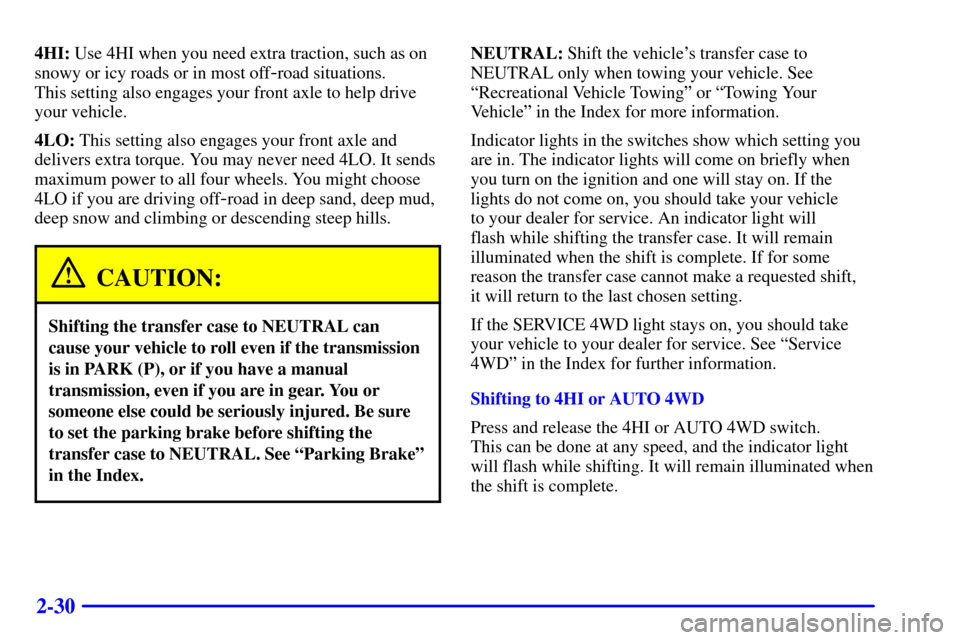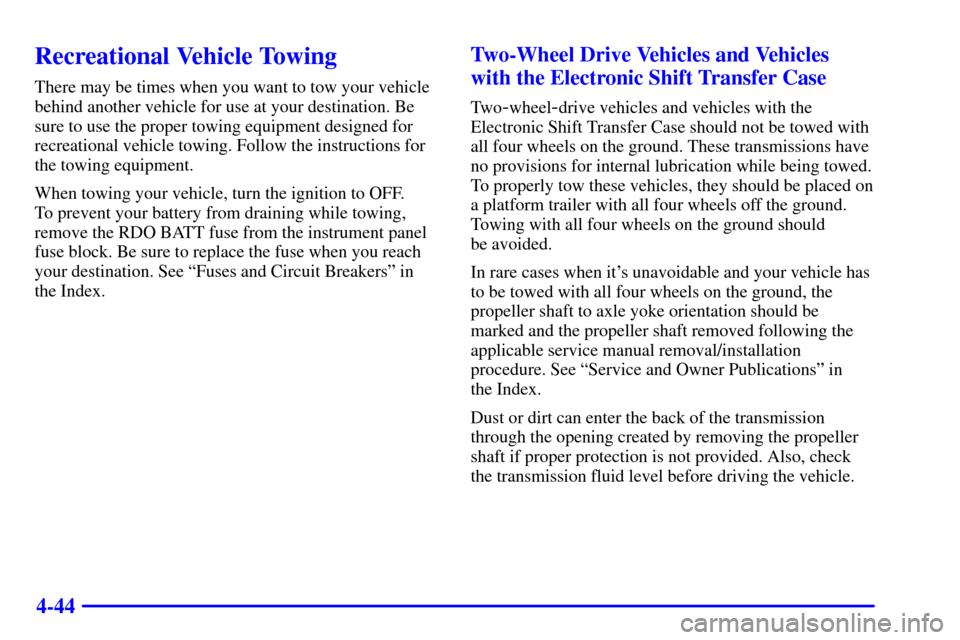Page 5 of 430
Comfort Controls and Audio Systems
Your Driving and the Road
Table of Contents (cont'd)
Braking/Anti-lock Brakes
Steering
Driving Tips for Various Road Conditions
Off-Road DrivingRecreational Vehicle Towing
Loading Your Vehicle
Towing a Trailer Heating and Air Conditioning
Setting the Radio Clock
Radio/Cassette Player/CD PlayerRadio Theft-Deterrent Feature
Steering Wheel Controls (If Equipped)
Hazard Warning Flashers
Jump Starting
Towing Your VehicleEngine Overheating
Changing a Flat Tire
If You're Stuck
Problems on the Road
iii
Section
5
Section
4
Section
3
Page 98 of 430

2-30
4HI: Use 4HI when you need extra traction, such as on
snowy or icy roads or in most off
-road situations.
This setting also engages your front axle to help drive
your vehicle.
4LO: This setting also engages your front axle and
delivers extra torque. You may never need 4LO. It sends
maximum power to all four wheels. You might choose
4LO if you are driving off
-road in deep sand, deep mud,
deep snow and climbing or descending steep hills.
CAUTION:
Shifting the transfer case to NEUTRAL can
cause your vehicle to roll even if the transmission
is in PARK (P), or if you have a manual
transmission, even if you are in gear. You or
someone else could be seriously injured. Be sure
to set the parking brake before shifting the
transfer case to NEUTRAL. See ªParking Brakeº
in the Index.
NEUTRAL: Shift the vehicle's transfer case to
NEUTRAL only when towing your vehicle. See
ªRecreational Vehicle Towingº or ªTowing Your
Vehicleº in the Index for more information.
Indicator lights in the switches show which setting you
are in. The indicator lights will come on briefly when
you turn on the ignition and one will stay on. If the
lights do not come on, you should take your vehicle
to your dealer for service. An indicator light will
flash while shifting the transfer case. It will remain
illuminated when the shift is complete. If for some
reason the transfer case cannot make a requested shift,
it will return to the last chosen setting.
If the SERVICE 4WD light stays on, you should take
your vehicle to your dealer for service. See ªService
4WDº in the Index for further information.
Shifting to 4HI or AUTO 4WD
Press and release the 4HI or AUTO 4WD switch.
This can be done at any speed, and the indicator light
will flash while shifting. It will remain illuminated when
the shift is complete.
Page 202 of 430
4-
4-1
Section 4 Your Driving and the Road
Here you'll find information about driving on different kinds of roads and in varying weather conditions. We've also
included many other useful tips on driving.
4
-2 Your Driving, the Road and Your Vehicle
4
-4 Defensive Driving
4
-4 Drunken Driving
4
-7 Control of a Vehicle
4
-8 Braking
4
-11 Steering
4
-13 Off-Road Recovery
4
-13 Passing
4
-15 Loss of Control
4
-16 Off-Road Driving with Your
Four
-Wheel-Drive Vehicle4
-30 Driving at Night
4
-31 Driving in Rain and on Wet Roads
4
-34 City Driving
4
-35 Freeway Driving
4
-36 Before Leaving on a Long Trip
4
-37 Highway Hypnosis
4
-38 Hill and Mountain Roads
4
-40 Winter Driving
4
-44 Recreational Vehicle Towing
4
-46 Loading Your Vehicle
4
-48 Towing a Trailer
Page 218 of 430

4-17
CAUTION:
�Cargo on the load floor piled higher than
the seatbacks can be thrown forward
during a sudden stop. You or your
passengers could be injured. Keep cargo
below the top of the seatbacks.
�Unsecured cargo on the load floor can be
tossed about when driving over rough
terrain. You or your passengers can be
struck by flying objects. Secure the
cargo properly.
�Heavy loads on the roof raise the vehicle's
center of gravity, making it more likely to
roll over. You can be seriously or fatally
injured if the vehicle rolls over. Put heavy
loads inside the cargo area, not on the roof.
Keep cargo in the cargo area as far forward
and low as possible.
You'll find other important information in this manual.
See ªVehicle Loading,º ªLuggage Carrierº and ªTiresº
in the Index.
Environmental Concerns
Off-road driving can provide wholesome and satisfying
recreation. However, it also raises environmental
concerns. GM recognizes these concerns and urges
every off
-roader to follow these basic rules for
protecting the environment:
�Always use established trails, roads and areas that
have been specially set aside for public off
-road
recreational driving; obey all posted regulations.
�Avoid any driving practice that could damage the
environment
-- shrubs, flowers, trees, grasses -- or
disturb wildlife (this includes wheel
-spinning,
breaking down trees or unnecessary driving through
streams or over soft ground).
�Always carry a litter bag . . . make sure all refuse is
removed from any campsite before leaving.
�Take extreme care with open fires (where permitted),
camp stoves and lanterns.
�Never park your vehicle over dry grass or other
combustible materials that could catch fire from the
heat of the vehicle's exhaust system.
Page 245 of 430

4-44
Recreational Vehicle Towing
There may be times when you want to tow your vehicle
behind another vehicle for use at your destination. Be
sure to use the proper towing equipment designed for
recreational vehicle towing. Follow the instructions for
the towing equipment.
When towing your vehicle, turn the ignition to OFF.
To prevent your battery from draining while towing,
remove the RDO BATT fuse from the instrument panel
fuse block. Be sure to replace the fuse when you reach
your destination. See ªFuses and Circuit Breakersº in
the Index.
Two-Wheel Drive Vehicles and Vehicles
with the Electronic Shift Transfer Case
Tw o-wheel-drive vehicles and vehicles with the
Electronic Shift Transfer Case should not be towed with
all four wheels on the ground. These transmissions have
no provisions for internal lubrication while being towed.
To properly tow these vehicles, they should be placed on
a platform trailer with all four wheels off the ground.
Towing with all four wheels on the ground should
be avoided.
In rare cases when it's unavoidable and your vehicle has
to be towed with all four wheels on the ground, the
propeller shaft to axle yoke orientation should be
marked and the propeller shaft removed following the
applicable service manual removal/installation
procedure. See ªService and Owner Publicationsº in
the Index.
Dust or dirt can enter the back of the transmission
through the opening created by removing the propeller
shaft if proper protection is not provided. Also, check
the transmission fluid level before driving the vehicle.